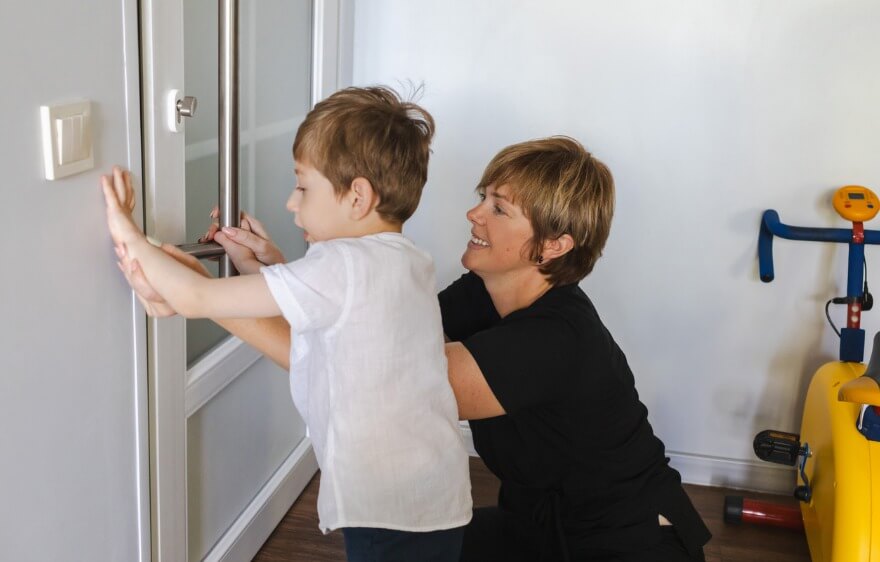Have you ever wondered what it’s like to be an occupational therapist who makes house calls? Home health occupational therapy is a unique and rewarding experience that takes OT beyond the walls of hospitals and clinics. Instead of seeing patients in a sterile, clinical environment, you get to help people in the comfort of their own homes — where they live, relax, and go about their daily lives. It’s personal, hands-on, and no two days are the same!
Whether you’re an OT curious about switching to home health or a patient wondering what to expect, this guide will give you the scoop on what makes home health occupational therapy special. Spoiler alert: it’s pretty awesome!
What is Home Health Occupational Therapy?
At its core, home health occupational therapy is all about helping patients live their best lives — right in their own homes. As a home health OT, you’ll be working with individuals to improve their ability to perform everyday activities, like getting dressed, cooking, or even taking a relaxing bath without assistance. Whether someone is recovering from surgery, managing a chronic illness, or navigating life with a disability, you’re there to help them regain independence and get back to doing the things they love.
Instead of seeing patients in a clinic or hospital, home health OTs meet their patients where they are — literally. You’ll visit patients in their homes, assess their environments, and create a customized plan of care that helps them overcome challenges in real-time. From recommending a grab bar in the bathroom to teaching someone how to safely navigate in the home, your role is to make life easier and safer for your patients, all within the space they live in.
The Home Health Occupational Therapy Experience Versus Hospital Settings
If you’re coming from a traditional hospital or clinic setting, you might be wondering how home health stacks up. Spoiler: it’s a whole different ball game! Let’s break down what sets home health occupational therapy apart from more traditional practice settings.
It’s All About Real Life, Not Simulations
Remember those mock kitchens and bedrooms in your OT training labs? Well, home health occupational therapy means you’re working in the real kitchen, where someone’s favorite cup is precariously perched on a high shelf and the cabinets are a little tricky to reach. Home health gives you the chance to see firsthand how the people you help, including young people, live and move around their actual homes.
Instead of working in a controlled environment like a hospital or clinic, you’re helping people overcome obstacles in the exact spaces they’ll be using every day. That could mean teaching a young child with a developmental delay how to interact with objects or helping someone figure out how to manage their steep staircase without fear. In other words, you’re helping them where it matters most.
Pros:
- You get to assess and treat in a real-life environment.
- You can address specific challenges unique to the client’s home.
- You’re making a difference in ways that are directly tied to their daily lives.
Cons:
- The home environment might be less controlled, with fewer tools and resources.
- Some homes come with their own unique set of logistical challenges — tiny bathrooms, anyone?
Freedom to Set Your Own Pace (Kind Of)
Tired of the hospital or clinic grind where you’re juggling multiple clients at once? One of the best perks of home health OT is the flexibility it offers. You get to plan your own schedule, moving from one family to the next, instead of being stuck in one building all day. Sure, you’ll still have clients to see, but the pace can be more relaxed, and you have the freedom to tailor each visit to the unique needs of each family.
You also get to spend more time with each person. No more rushing through 20-minute sessions! Home health OTs typically have longer, one-on-one sessions, which means you can really dig deep and focus on what matters. Plus, you’ll be building relationships, not just checking boxes.
Pros:
- You’re in control of your own schedule — hello, work-life balance!
- You get to spend more quality time with each person.
- Say goodbye to the chaos of juggling multiple people at once.
Cons:
- You’ll need to factor in travel time between families.
- It’s just you out there — no in-person teams like you’d have in a hospital.
At Care Options for Kids, we’re committed to help our home health occupational therapists thrive in a community of support. In addition to full administrative and clinical assistance being available round-the-clock, our vibrant community of therapists engage in regular meetings and social events, creating a strong professional and emotional support network.
One-on-One Time with Patients
In a clinic or hospital, you might feel like you’re constantly running from one patient to the next. But in home health, you get the luxury of truly getting to know the families you’re helping. You’ll be spending one-on-one time with them in their homes, which means you’ll develop strong relationships and get to personalize your care in ways that aren’t always possible in other settings.
You’re not just teaching people how to improve their motor skills — you’re helping them live more independently in their actual space. Whether that’s learning sensory play or overcoming ADHD, it’s all about making life better for them in the here and now.
Pros:
- You get to know your patients on a personal level.
- The therapy is more focused and tailored to their everyday needs.
- You can make a real difference in their quality of life.
Cons:
- You might miss the camaraderie of a team-based setting.
- Sometimes it’s just you, a patient, and a lot of expectations to meet!
What Home Health Occupational Therapy Looks Like in Real Life
So, what does a day in the life of a home health OT look like? Let’s break it down into three main parts: the initial assessment, the hands-on therapy, and working with caregivers or family members.
1. The First Visit: Assessing the Situation
The first time you visit a new client, you’ll be doing a lot of detective work. Your job is to figure out how they’re managing their daily life and what kind of help they need. Are there stairs that are hard to climb? Is the bathroom a bit of a hazard zone? You’ll assess their home environment and get a sense of what obstacles they’re facing.
This is where your OT skills really shine. By evaluating their living space, you’ll be able to create a game plan that works for them. Whether it’s recommending adaptive equipment or teaching them new strategies to handle their daily activities, your goal is to make their home as safe and functional as possible.
2. Hands-On Therapy: Let’s Get to Work!
Once the assessment is done, the real fun begins — therapy time! You’ll work with clients to implement strategies and exercises that will help them regain or maintain their independence. Maybe you’re showing them how to transfer safely from a chair to a bed, or maybe you’re working on strength and coordination exercises they can do while sitting at the kitchen table.
For pediatric patients, therapy might involve turning everyday activities into games, helping kids build their fine motor skills or improve their sensory processing. It’s a creative and flexible approach that you won’t always find in other settings.
3. Caregiver Training: Teamwork Makes the Dream Work
One of the coolest parts about home health OT is getting to work with families and caregivers. You can show them how to support the patient’s progress, whether that means demonstrating exercises or offering tips on how to modify the home to make life easier. It’s a team effort, and you’re the one leading the way!
The Pros and Cons of Home Health OT
So, is home health OT all it’s cracked up to be? Here’s a quick rundown of the perks and a few challenges:
Pros:
- You’re helping people right in their own homes, solving real-life problems.
- You get to be your own boss and set a flexible schedule.
- You’ll build strong, meaningful relationships with people and families.
Cons:
- Travel can add up, especially if you’re covering a large area.
- You have to adapt the home setting to care plans instead of using a dedicated therapy room.
- Working solo can sometimes feel a little isolating.
Is Home Health Occupational Therapy Right for You?
Home health occupational therapy is an amazing way to make a direct impact on your patients’ lives. It’s flexible, personal, and incredibly rewarding. If you love the idea of helping people regain their independence in the spaces they know best — whether it’s a cozy living room or a kitchen full of memories — then home health might just be the perfect fit for you.
Home health offers a level of autonomy, flexibility, and patient connection that’s hard to beat. Ready to trade in the clinic for the comfort of your patients’ homes? Join our amazing team!
Join the Care Options For Kids Team!
Are you ready for meaningful work that comes with benefits and not burnout? Join the compassionate care team that helps children and families live their best lives. Our clinicians provide best-in-class pediatric nursing, therapy, and school-based services. We bring individualized care to children where they live, work, and play. We have opportunities in homes, schools, and clinics across the country.
Apply at Care Options for Kids now. We make it easy to start so you can make a difference as soon as possible.






